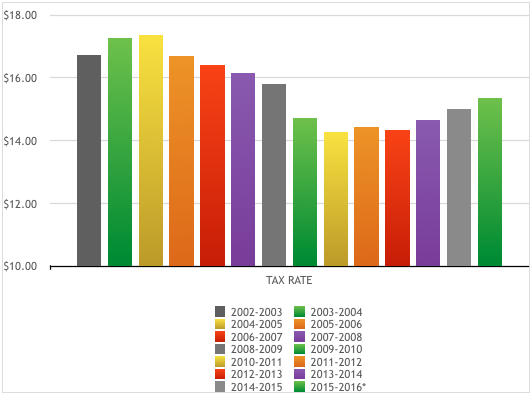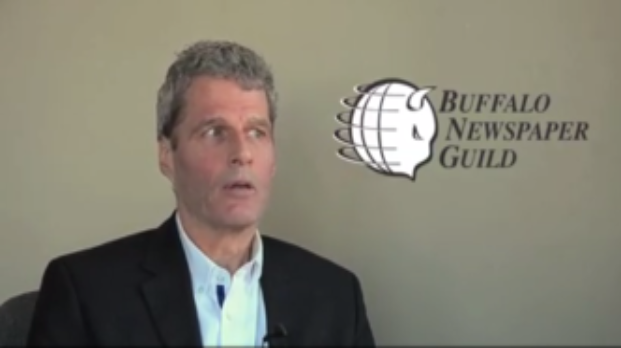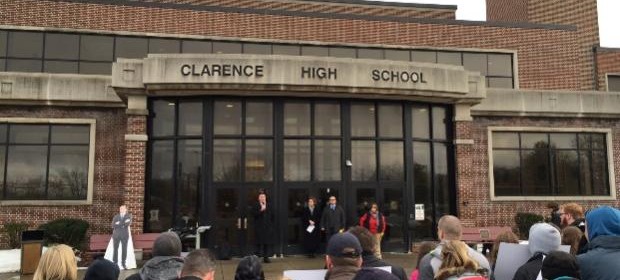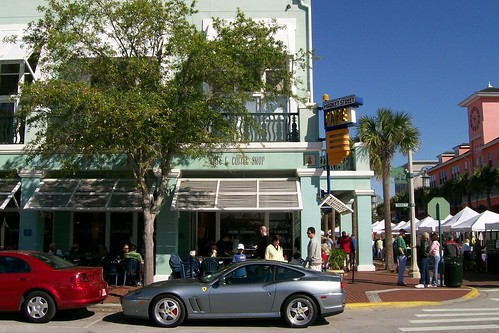When you wage war on the public schools, you’re attacking the mortar that holds the community together. You’re not a conservative, you’re a vandal. – Garrison Keillor
Maybe Donn Esmonde is too busy with his new hobby of trying to be a retiree version of Bernice Radle, rehabbing dilapidated investment properties on the West Side of Buffalo, but his opinions and pronouncements on the issue of education have reached the status of self-parody. On Sunday, he published a column praising a proposal to set up a charter boarding school, because some Buffalo kids’ home life is so dysfunctional, the only way they can get a fair shot at advancement is to get out of their neighborhoods and homes.
That is, of course, a horrific indictment of the effects of poverty, fear, and crime that pervades some families and neighborhoods in Buffalo. It is also evidence of how poorly any and every effort by society, faith, government, or community to change that status quo has worked. I don’t know whether it is appropriate for the public school system to spend upwards of $25,000 per boarding school pupil to give them a chance to succeed, but we live in a time of public school privatization and student compartmentalization in districts like Buffalo, and the school board has a majority now that is in favor of privatization and charter expansion.
It’s amazing that Esmonde and his charter proponent allies are so comfortable spending tax money on a quasi-private, selective boarding school, but he spits fire and hatred at the notion of adequately funding suburban districts. To Esmonde’s mind, suburbs = bad and city = good, and those basic equations inform everything he writes.
In Clarence, which spends just over $14,000 per pupil, Esmonde sided with the people who would dismantle public education. After all, suburbs = bad. He wrote two columns – here and here – that could only be characterized as Esmonde’s way of punishing suburban students and teaching them a lesson for the crime of being born to educated or well-to-do parents, and for what he considers to be poor geographics.
In that first article that Esmonde wrote, he praised “reformer” Roger Showalter, who is now a member of the Clarence school board. In fact, Showalter has been a member of the board for almost two years.
Where is his “reform”? What proposal has he put forward to fundamentally change, “the cost structure”?
Currently, an influx of state aid has helped Clarence out. Instead of raising the local levy to the 4.7% cap, the Superintendent proposes a rise of 3.9%, and restoring 11 positions out of the 113 that have been lost through budget cuts and attrition since 2011. Yet “reformer” Showalter is reportedly refusing to consider these 11 positions – 2 ELA and 2 math teachers to meet state mandates and serve students who need intervention, a special ed teacher to meet state mandates and serve elementary students, freeing up the special ed teacher they share with the middle school, 1 Elementary teacher at Harris Hill to address class sizes and rising enrollment, 1 technology and 1 business teacher at the CHS to serve needed electives to prepare students to be competitive in our global economy, 1 districtwide music teacher to alleviate class sizes, and 2 elementary librarians to restore full-time librarians at all elementary schools.
None of that is fluff, excess, or unnecessary – all of these positions are needed.
Esmonde’s “reformer” Showalter argues that it doesn’t matter what the board or administration “want”, or what would be “nice to have”, but, “what is financially viable in the long term.” He adds that he believes that this restoration, “sends us down the same path that got us into budget trouble before and is not fiscally prudent. I won’t support it.” This is a fundamental re-write of history, and his logic is faulty. Furthermore, his position – I can’t in good conscience call it an argument – is an outcrop of the standard argument from the typical Clarence anti-school activists: the teachers are the villains.
Donn Esmonde and Roger Showalter believe that Clarence schools are great because we have involved, concerned parents, and families send good “quality” students (whatever that means) to the district, so the excellence of the schools can be maintained, no matter how much is cut. He believes that we can’t “throw money” at education, because Buffalo spends far more than Clarence and produces far worse results. In 2012, Showalter claimed that cuts wouldn’t affect his kids, and that he was for more cuts to “get rid of the extra fluff” in the curriculum.
Indeed, he brushes off the curriculum as unimportant – only “core” classes that prepare kids to compete in the “global economy” matter. Small class sizes – unimportant, too. He believes that the value comes not from extracurriculars, but from our lower tax rate. Likewise, Mr. Showalter is unconcerned with teacher morale and workload. Specifically, he thinks that teacher morale can be improved by instituting a system that rewards teachers for good performance, and getting rid of teachers who “do not perform”. He claims that the tenure system removes “incentive for good teaching”.
Socioeconomics
It’s true that Clarence’s socioeconomic reality translates into an easier job for our schools. Because Clarence – as a town – attracts families who are looking for quality, low-tax public schools, our families have an especial interest in the education their kids receive. We have far less poverty in our town, which is one of the wealthiest in Erie County. Despite that, as recently as 2013 it was revealed that 8.7% of students were receiving benefits under a free federal lunch program for families in poverty. In 2007, only 4% of kids were on that program.
No matter what the school board does – it has a duty to do right by those kids who have the least.
Socioeconomics have an affect on our schools – that’s why our cost per pupil is the 2nd lowest in Erie County, and 6th lowest in the entire state. That’s why we’re the third most cost-effective district in the 8 counties of western New York, and 6th in administrative efficiency. Clarence is third in academic rankings in WNY. We have been first before, and we should be first again. Striving for anything less does a disservice to students and taxpayers. Are we teaching kids that third is good enough? Back in 2012, Mr. Showalter told whomever would listen – including Donn Esmonde – that people were playing Chicken Little by claiming that additional cuts would cause the sky to fall. How wrong he was. If he was that wrong then, how can we trust anything he says now?
- Since 2011, the district has cut 113 full-time positions; 53 of them in 2013 alone.
- In 2013, the high school lost art, math, English, tech, and business teachers. The entire family & consumer science department was cut, and we lost a guidance counselor.
- In 2013, the middle school lost an art, English, and science teacher.
- In 2013, the cuts in the revote budget eliminated 3 K-5 teachers, two librarians, and 12 teacher’s aides.
- In 2013, the cuts in the revote budget eliminated four music teachers, the last social worker, and summer school.
- In 2013, the cuts in the revote budget eliminated 23 high school clubs and extracurricular activities
- In 2013, the cuts in the revote budget eliminated 15 middle school clubs and extracurricular activities
- When these clubs are eliminated, parents must find privately funded alternatives. This hurts the poorest families – that 8.7% – hardest.
- In 2013, the revote budget eliminated all HS freshman sports, affecting 90 kids.
- In 2013, the revote budget eliminated all modified sports in the middle school, affecting 225 kids.
CSEF was able to restore sports and clubs. But that isn’t how this should work.
Weaning the District From State Aid
We can concede that perhaps not all of the 113 lost positions must be restored, but certainly some should. Mr. Showalter wants the district to “wean” itself off of state aid, but that makes no sense. For starters, the district has “weaned” itself off of the $16 million in state aid that Albany owes – but hasn’t paid – thanks to the gap elimination adjustment.
Perhaps Mssrs. Showalter and Esmonde think that it benefits local taxpayers to shoulder a greater town tax burden thanks to state aid stolen from kids to balance the state budget, but most people would disagree. It is, in actuality, a fiscally obnoxious accounting gimmick resulting in schoolkids plugging holes in the state budget. Our school districts are subsets of the state education system, and why shouldn’t taxpayers throughout the state share in the cost of educating children within the state? Where does this limited thinking end? Should Erie County “wean” itself off of funding and maintenance provided by the State DOT and instead demand local funding of local roads?
This parochial “only Clarence money for Clarence kids” mindset is not only unrealistic and shortsighted, but would bring about two completely unacceptable results: shift all of the funding burden on local taxpayers, wildly increasing the tax levy and rate; and/or making permanent the sorts of district-killing cuts that came about in 2013. Neither alternative is acceptable.
Path of Fiscal Imprudence
Mr. Showalter will have you believe that it was the teachers who are to blame for the crisis of 2013. This is false, and while he will accuse this of playing “victim” politics, his characterization doesn’t make it any less untrue. Facts are facts. The global financial economic meltdown brought about an historic stock market crash. Few people recall this:

The teacher’s pension system invests in the stock market, and the state pension fund must continue to pay out benefits regardless of how the market performs. When the stock market crashes and the pension fund loses money, taxpayers have to make up the difference.
In the wake of the 2008 – 2009 crash, analysts at the Manhattan Institute estimated that contributions to the NYS Teachers’ Retirement System would have to quadruple for up to five years to account for the market crash. The problem wasn’t the pensions – it was the unanticipated and practically unprecedented economic emergency. It wasn’t the teachers who were at fault – they did nothing to precipitate the financial disaster.
Before anyone assails the pension system itself, consider that every dollar spent on New York City’s pension benefits results in almost $2.00 in local economic activity, and they’re administered 40% more cheaply than defined contribution plans or 401(k)s. But the “path” that led to the budget crisis of 2012 and 2013 is long gone – the chart reveals that the Dow is now at record highs.
What happened was that the federal government, through President Obama’s stimulus package, provided financial aid to local school districts to alleviate pressures caused on budgets due to the crash. When that money dried up, but the pension issues were still ongoing, the district found itself in dire financial straits. But all that is now behind us. It wasn’t teachers or social workers or guidance counselors or librarians who brought about Clarence’s financial crisis.
Instead, it was matters entirely out of anyone’s control. These are facts, not theories. Restoring 11 positions won’t result in the Dow plummeting back to 8,000 and another five years of taxpayer hurt. Instead, it will help students and the district, and in turn provide taxpayers with a direct benefit. They’re not just wildly spending money, they’re making an investment – an investment in their homes and community, and an investment in the next generation.
Esmonde and his “reformer” ally – whose only reform seems to be voting “no” – continue to blame teacher salaries and benefits.
Extracurriculars and “fluff”
Is music education “fluff”? What about athletics? Art? The business academy? The various clubs and teams? What, precisely, would he comfortably eliminate? We could counter by asking what sort of a world this would be without music, art, and athletics, but let’s keep it to school curricula. Teaching kids how to be musically and artistically creative trains their brains to think creatively in all aspects of their lives. An arts curriculum results in improvement in…
…math, reading, cognitive ability, critical thinking, and verbal skill. Arts learning can also improve motivation, concentration, confidence, and teamwork.
That doesn’t sound like unnecessary fluff. A music curriculum throughout a kid’s school career has myriad cognitive pay-offs, including enhanced language skills, increased IQ, a more efficient brain, and improved test scores. Time and again, studies have shown the importance of a strong music curriculum on kids’ overall development.
Of course, strengthening our STEM curriculum is important, but if our kids have a solid foundation in the arts, they’ll perform better in those areas that help them compete in the global economy. By the way, the schools’ job is to educate all kids in the system, and frankly, some of them want to become professional artists or musicians, and we owe them a duty to provide them with that opportunity.
Teacher Morale and Performance
Teacher morale is important because a happy teacher means a happy classroom and happy students. Treating teachers like fungible commodities isn’t going to do anyone any favors – not the taxpayer nor the district. Almost 85% of Clarence teachers – in management speak – “exceed expectations”; are “highly effective”. The remaining 15% are “effective” or “meet expectations”.
There are no teachers in our local district who “do not perform”. His central premise is completely manufactured out of thin air. Clarence, of all places, doesn’t need lectures about getting rid of ineffective teachers. Furthermore, he argues that tenure serves as a disincentive for “good teaching”. Tell it to Valerie Acee, who was a tenured music teacher who was fired in the 2013 cuts. Tell it to Michael Vertoske – a prolific composer and caring teacher – whom Clarence fired, and whom Williamsville quickly snapped up to its benefit and Clarence’s detriment. Tell it to the eager, younger teachers who were let go in 2013, completely undermining Mr. Showalter’s point.
But here’s the thing, if he truly thinks that we need a system that rewards teachers for good performance, where is it? He’s been on the board for two years, and I have not seen a single proposal – from him or anyone – to implement a system to reward the 85% of teachers who exceed expectations and are highly effective. By his own logic, an overwhelming majority of Clarence teachers are eligible for his reward system. Where is it?
Conclusion
The emergency is over, and the outlook is good. It is time to rebuild our district, and restore some of what we’ve lost. We’re not saying we need to go back to the 2005 status quo, although it would be great if we could restore the enrichment program. We’re saying that scaremongering over the tax rate is false, and the people who are against restoration (not to mention the outside school “no” opponents) are wrong. Why? Check the data:

We’re not even close to the exorbitant tax rates we had a decade ago. Donn Esmonde is a liar, and his “reformer” Showalter has reformed nothing. He hasn’t even proposed any sort of reform.
Clarence’s school budget vote is coming May 19th, and the final form is still being worked out. Follow along at this link for news and information.
 Every so often, people ask me when/why/for how long I have been maintaining my
Every so often, people ask me when/why/for how long I have been maintaining my 


 As a general reminder, please reacquaint yourself with the notion that Donn Esmonde – the News columnist who won’t leave – is an unethical, morally repugnant, tea partying ass.
As a general reminder, please reacquaint yourself with the notion that Donn Esmonde – the News columnist who won’t leave – is an unethical, morally repugnant, tea partying ass.



 Let’s get something clear, here. Donn Esmonde is a hypocrite. He is a
Let’s get something clear, here. Donn Esmonde is a hypocrite. He is a 

 Endorsements will come tomorrow both in text and by way of a
Endorsements will come tomorrow both in text and by way of a